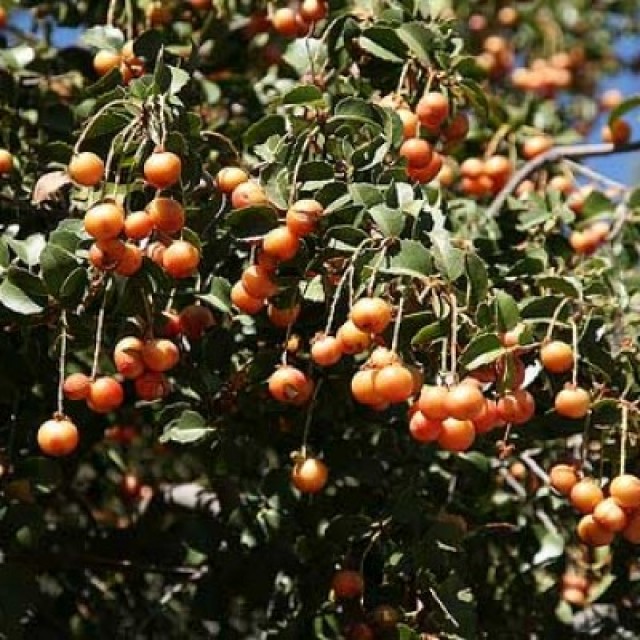COMMON NAME
Holly-leafed cherry
SCIENTIFIC NAME
Prunus ilicifolia
ALSO KNOWN AS
Evergreen cherry, Hollyleaf cherry
Plant family
Rose (Rosaceae)
Plant group
Broadleaf Evergreens
An evergreen shrub or small tree with dense foliage that grows up to 15 m tall (50 ft.)The leaves have spiny margins, somewhat resembling those of the English holly, hence its name. The flowers are small, white, and produced on racemes. The fruit is a small cherry that is sweet but has very little edible flesh.
35 reports
21+
OBSERVERS
35+
OBSERVATIONS
Identification hints
Cherries in general are distinctive mostly in their fruit, otherwise they can be easily confused with other members of the Rose family such as apples, or plums. They tend to have narrow leaves with long stalks (petioles) which are alternately arranged. There are 6 common wild species of cherry that you can find in chaparral habitats in California. Holly-leafed cherry is unique in having leathery, evergreen leaves usually with a spiny margin (like holly, hence its name). The other species have thin deciduous leaves without distinctive teeth or spines. On the Channel Islands, a unique subspecies has a flatleaf (rather than wavy) and entire leaf margins (rather than spiny-toothed).
Did you know?
Although the fruits of the Holly-leafed cherry are edible, you'll notice that each fruit contains a lot more "pit" and a lot less "flesh" than the cherries that we buy at the grocers. This is because wild cherry species haven't been bred to maximize the ratio of edible flesh to inedible seed. Native Californian Salinan Indians called this plant "slay" (the Spanish version of which is "islay", and prepared a meal from the roasted and pounded seeds that are found within the hard pit. The meal, in turn, was used to prepare tamales, tortillas, and gruel. The seeds contain hydrocyanic acid (a highly toxic compound) and therefore require a long period of leaching and several washes before ingestion.
DISTRIBUTION IN TH U.S.
California
HABITAT
This shade-tolerant shrub or tree occurs in the Coastal Range of California from Napa County south to Baja, where it prefers moister microclimates and well-drained soils among the chaparral and woodlands it occupies below 5249 ft (1600 m) in elevation. Holly-leafed cherry particularly favor sheltered canyons and north-facing slopes. They can often survive wildfire by re-sprouting from their root crowns. There’s a subspecies of this shrub (ssp. lyonii) that is limited to the Channel Islands in California.
ATTRIBUTES
Leaves
The dark green and shiny leaves vary in length from about 0.78 to 4.7 in (2 to 12 cm). The leaves of the Holly-leafed cherry can be wavy, and often have spiny-toothed margins somewhat similar to English holly. The lower leaf surface is pale, and leaves are arranged oppositely along the stem
Flowers
The flowers have small (0.04 to 0.2 in or 1 to 5 mm) pedicels (stems that attach single flowers to the main stem of the inflorescence). The small 0.04 to 0.12 in (1 to 3 mm) long petals are white. The flowers are bisexual which means that they have both male and female reproductive organs. The inflorescences are arranged in cylindrical clusters (racemes with short pedicels) of several to many flowers. Holly-leafed cherry blooms in the spring, generally from March to May.
Fruits
Not all flowers develop into a fruit, but successful flowers each develop into a red to blue-black oneseeded drupe (the cherry) containing a single hard-walled pit. Fruits are round to oval, and 0.5 to 1.0 in (12 to 25 mm) in diameter. The layer of sweet flesh surrounding the pit is 0.04 to 0.12 in (1 to 3 mm) thick. Fruits generally ripen in mid to late summer and even into the autumn, and often persisting through December.
See Menu
- 2021 Chicago Botanic Garden. All Rights Reserved.
-
Creative Commons
BY-NC-SA 4.0 - Terms of Use
- Privacy Policy
- Data Sharing and Citation Policies
- 2021 Chicago Botanic Garden. All Rights Reserved.



